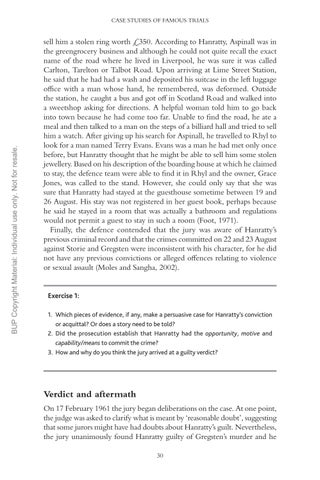BUP Copyright Material: Individual use only. Not for resale.
CASE STUDIES OF FAMOUS TRIALS
sell him a stolen ring worth £350. According to Hanratty, Aspinall was in the greengrocery business and although he could not quite recall the exact name of the road where he lived in Liverpool, he was sure it was called Carlton, Tarelton or Talbot Road. Upon arriving at Lime Street Station, he said that he had had a wash and deposited his suitcase in the left luggage office with a man whose hand, he remembered, was deformed. Outside the station, he caught a bus and got off in Scotland Road and walked into a sweetshop asking for directions. A helpful woman told him to go back into town because he had come too far. Unable to find the road, he ate a meal and then talked to a man on the steps of a billiard hall and tried to sell him a watch. After giving up his search for Aspinall, he travelled to Rhyl to look for a man named Terry Evans. Evans was a man he had met only once before, but Hanratty thought that he might be able to sell him some stolen jewellery. Based on his description of the boarding house at which he claimed to stay, the defence team were able to find it in Rhyl and the owner, Grace Jones, was called to the stand. However, she could only say that she was sure that Hanratty had stayed at the guesthouse sometime between 19 and 26 August. His stay was not registered in her guest book, perhaps because he said he stayed in a room that was actually a bathroom and regulations would not permit a guest to stay in such a room (Foot, 1971). Finally, the defence contended that the jury was aware of Hanratty’s previous criminal record and that the crimes committed on 22 and 23 August against Storie and Gregsten were inconsistent with his character, for he did not have any previous convictions or alleged offences relating to violence or sexual assault (Moles and Sangha, 2002).
Exercise 1: 1. Which pieces of evidence, if any, make a persuasive case for Hanratty’s conviction or acquittal? Or does a story need to be told? 2. Did the prosecution establish that Hanratty had the opportunity, motive and capability/means to commit the crime? 3. How and why do you think the jury arrived at a guilty verdict?
Verdict and aftermath On 17 February 1961 the jury began deliberations on the case. At one point, the judge was asked to clarify what is meant by ‘reasonable doubt’, suggesting that some jurors might have had doubts about Hanratty’s guilt. Nevertheless, the jury unanimously found Hanratty guilty of Gregsten’s murder and he 30

